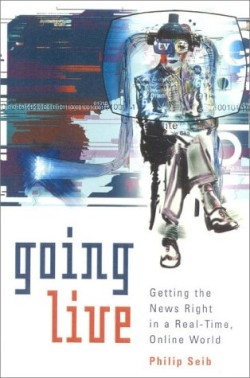Going Live
Getting the News Right in a Real-Time Online World
Scene 1: The man with the rifle has been holding police at bay for several hours on the Los Angeles freeway. He has fired some shots but hasn’t hit anyone. Local television stations are providing live, nonstop coverage of the standoff from their helicopters and ground units… Finally, the man places his weapon under his chin. The television stations do not break away or pull back from their tight shots. A few seconds later, the man pulls the trigger. He dies at the scene.
Going Live is a thoughtful examination of recent changes in the news media. In essence the book looks at the increase in and emphasis upon speed of delivery, prodded by television, and the morphing of news from a summary/analysis-based enterprise, to a raw content-based enterprise. With television as the catalyst, Seib shows how speed of delivery, and not analysis, is driving news programming. Whether the content needs speed or not, the result is the rapid deterioration of traditional journalistic standards in the face of this onslaught. In the quoted example readers are lead to examine whether this coverage, with all of its drama and tragedy is really news at all, or whether people are merely captive to images that block abilities to analyze the relationships that emerge between this gunman and the audience.
What is particularly unsettling about this deterioration is the new mechanism of the Web that makes “at the moment of origin delivery” not only possible, but probable. In a balanced manner Seib examines both the positive aspects of this and the more obvious failings. There are no villains, but market forces and competition are shifting people’s ability to pause long enough to evaluate what is unfolding. The ultimate goal is to help the consumer sort out what is true, accurate, and fair in the news that is seen every day.
The book is organized into seven chapters: The World Is Watching, The Allure and Impact of Live, From Broadcast to Cable to Web, Newspapers’ New World, Adventures in Convergence, The Ethics Minefield, and Sailing the Uncharted Sea. What makes this book so thought provoking is the author’s exploration of the relationships between forms of media. It is not uncommon for writers to denigrate the Web or electronic media, but this book shows the circular relationship of influences that will change not only the Web, but will ultimately impact radio, television, and the print media.
Reviewed by
Peter Terry
Disclosure: This article is not an endorsement, but a review. The publisher of this book provided free copies of the book to have their book reviewed by a professional reviewer. No fee was paid by the publisher for this review. Foreword Reviews only recommends books that we love. Foreword Magazine, Inc. is disclosing this in accordance with the Federal Trade Commission’s 16 CFR, Part 255.

